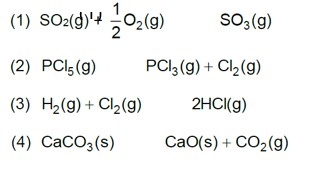Assertion (A): In the dissociation of PCl5 at constant pressure and temperature addition of helium at equilibrium increases the dissociation of PCl5 .
Reason (R) : Helium removes Cl2 from the field of action.
(i) Both A and R are true and R is correct explanation of A.
(ii) Both A and R are true but R is not correct explanation of A.
(iii) A is true but R is false.
(iv) Both A and R are false.
Assertion (A): In the dissociation of PCl5 at constant pressure and temperature addition of helium at equilibrium increases the dissociation of PCl5 .
Reason (R) : Helium removes Cl2 from the field of action.
(i) Both A and R are true and R is correct explanation of A.
(ii) Both A and R are true but R is not correct explanation of A.
(iii) A is true but R is false.
(iv) Both A and R are false.
-
1 Answer
-
This is a Assertion and Reason Type Questions as classified in NCERT Exemplar
Ans: option (iv)
If the volume is kept constant and an inert gas such as argon is added which does not take part in the reaction, the equilibrium remains undisturbed.
Similar Questions for you
0.01 M NaOH,
M = 1 * 10-2

pOH = 2
pH = 2
Kp = Kc (RT)Dng
36 * 10–2 = Kc (0.0821 * 300)–1
Kc = 0.36 * 0.0821 * 300 = 8.86 » 9
A(g) ->B(g) + (g)
Initial moles n 0 0
Eqb. moles n(1 – a) na
total moles =
Eqb. pressure
On increasing pressure, equilibrium moves in that direction where number of gaseous moles decreases.
Taking an Exam? Selecting a College?
Get authentic answers from experts, students and alumni that you won't find anywhere else
Sign Up on ShikshaOn Shiksha, get access to
- 66k Colleges
- 1.2k Exams
- 680k Reviews
- 1800k Answers


